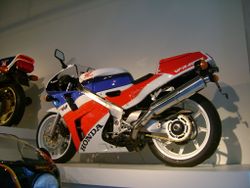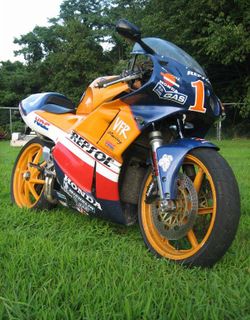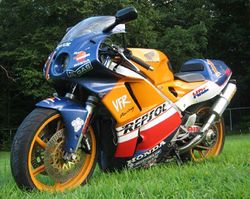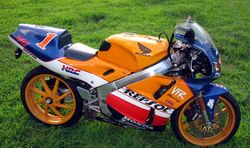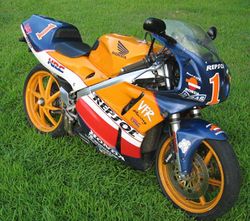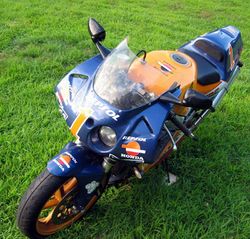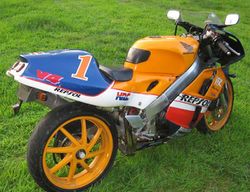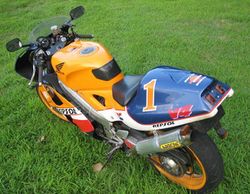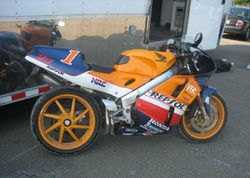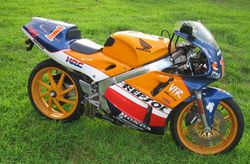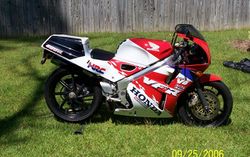Difference between revisions of "Honda VFR400"
m |
|||
| Line 1: | Line 1: | ||
[[Image:1990 Honda VFR400R (NC30).jpg|right|thumb|1990 Honda VFR400R (NC30)]] | |||
The '''Honda VFR400''' [[motorcycle]] was a scaled down version of the VFR models of the day. | The '''Honda VFR400''' [[motorcycle]] was a scaled down version of the VFR models of the day. | ||
The VFR is the NC30, and the RVF is the NC35; these being the bigger engined version of the [[Honda VFR750R|RC30]] and [[Honda RVF750|RC45]]. The RVF was originally created for the [[Isle of Man TT]], considered by many to be the pinnacle of [[motorcycle]] road racing. The Isle of Man TT was the proving ground for Honda's new racing ability, in the form of the RVF. They were manufactured mainly for the Japanese market, where licenses for bikes over 400 cc are more difficult to obtain: the smaller bikes were made for the home market while the big [[superbikes]] where shipped over seas. However, the VFR400 is a popular grey imported motorbike (into the UK, and some for racing in the states) in the "mini" superbike segment. The VFR400 motor produces a noticeable whine when the engine is running due to cams being driven by gears and not chains or belts. The bikes are also not as wide as inline 400 cc sports bikes due to the "V" engine configuration. They also have considerably more torque. In the Japanese markets the 400 are resricted to 59 horsepower (44 kW), but an ignition "black box" can be purchased to raises it along with many other upgrades and custom-machined parts. | The VFR is the NC30, and the RVF is the NC35; these being the bigger engined version of the [[Honda VFR750R|RC30]] and [[Honda RVF750|RC45]]. The RVF was originally created for the [[Isle of Man TT]], considered by many to be the pinnacle of [[motorcycle]] road racing. The Isle of Man TT was the proving ground for Honda's new racing ability, in the form of the RVF. They were manufactured mainly for the Japanese market, where licenses for bikes over 400 cc are more difficult to obtain: the smaller bikes were made for the home market while the big [[superbikes]] where shipped over seas. However, the VFR400 is a popular grey imported motorbike (into the UK, and some for racing in the states) in the "mini" superbike segment. The VFR400 motor produces a noticeable whine when the engine is running due to cams being driven by gears and not chains or belts. The bikes are also not as wide as inline 400 cc sports bikes due to the "V" engine configuration. They also have considerably more torque. In the Japanese markets the 400 are resricted to 59 horsepower (44 kW), but an ignition "black box" can be purchased to raises it along with many other upgrades and custom-machined parts. It was only available in two European countries in very limited numbers, less than 250 machines being produced. | ||
The VFR400 evolved into the [[Honda RVF400|RVF400]]. The RVF400 was and still is considered by some to be the pinnacle of small road bikes. It has inverted forks, a V-4 engine, a single-sided swing arm, and racing-style fairing. Even though [[Honda]] stopped production of the RVF400 in 1998 the bike is still a popular model. | The VFR400 evolved into the [[Honda RVF400|RVF400]]. The RVF400 was and still is considered by some to be the pinnacle of small road bikes. It has inverted forks, a V-4 engine, a single-sided swing arm, and racing-style fairing. Even though [[Honda]] stopped production of the RVF400 in 1998 the bike is still a popular model. | ||
Revision as of 13:37, 4 July 2010
The Honda VFR400 motorcycle was a scaled down version of the VFR models of the day. The VFR is the NC30, and the RVF is the NC35; these being the bigger engined version of the RC30 and RC45. The RVF was originally created for the Isle of Man TT, considered by many to be the pinnacle of motorcycle road racing. The Isle of Man TT was the proving ground for Honda's new racing ability, in the form of the RVF. They were manufactured mainly for the Japanese market, where licenses for bikes over 400 cc are more difficult to obtain: the smaller bikes were made for the home market while the big superbikes where shipped over seas. However, the VFR400 is a popular grey imported motorbike (into the UK, and some for racing in the states) in the "mini" superbike segment. The VFR400 motor produces a noticeable whine when the engine is running due to cams being driven by gears and not chains or belts. The bikes are also not as wide as inline 400 cc sports bikes due to the "V" engine configuration. They also have considerably more torque. In the Japanese markets the 400 are resricted to 59 horsepower (44 kW), but an ignition "black box" can be purchased to raises it along with many other upgrades and custom-machined parts. It was only available in two European countries in very limited numbers, less than 250 machines being produced.
The VFR400 evolved into the RVF400. The RVF400 was and still is considered by some to be the pinnacle of small road bikes. It has inverted forks, a V-4 engine, a single-sided swing arm, and racing-style fairing. Even though Honda stopped production of the RVF400 in 1998 the bike is still a popular model.
1990
1993
